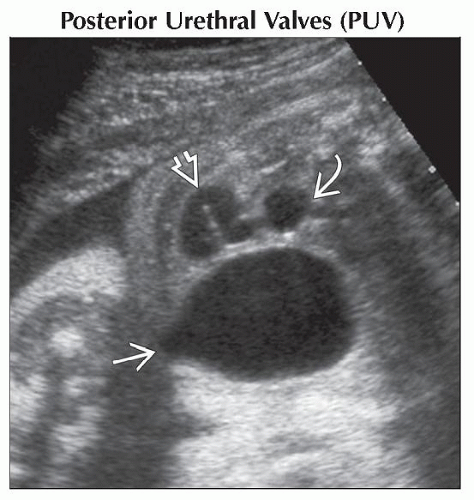Large Bladder
Paula J. Woodward, MD
DIFFERENTIAL DIAGNOSIS
Common
-
Normal
-
Posterior Urethral Valves (PUV)
Less Common
-
Prune Belly Syndrome
-
First Trimester Megacystis
Rare but Important
-
Urethral Atresia
-
Megacystis Microcolon
ESSENTIAL INFORMATION
Helpful Clues for Common Diagnoses
-
Normal
-
Transient finding with otherwise normal urinary tract & amniotic fluid volume
-
Fetus will usually void during exam
-
Follow-up if bladder fails to decompress
-
-
-
Posterior Urethral Valves (PUV)
-
Urethral membrane acts as valve, resulting in bladder outlet obstruction
-
Occurs exclusively in males
-
“Keyhole” sign: Distended bladder “funnels” into dilated posterior urethra
-
Bladder often thick-walled, with degree of distention depending on severity of obstruction
-
Hydronephrosis common with potential development of renal dysplasia
-
Typically oligohydramnios, or even anhydramnios, in severe obstruction
-
Helpful Clues for Less Common Diagnoses
-
Prune Belly Syndrome
-
Triad of dramatic collecting system dilatation, deficiency of abdominal musculature & cryptorchidism
-
Often difficult to differentiate from PUV
-
Look carefully at urethra
-
Entire urethra may be dilated
-
Does not terminate at posterior urethra
-
May see spontaneous voiding
-
-
-
First Trimester Megacystis
-
Bladder length > 7 mm at 10-14 weeks
-
25% reported to have aneuploidy (trisomy 13, trisomy 18 most common)
-
Of those that are chromosomally normal, 90% regress while 10% progress to obstructive uropathy
-
Helpful Clues for Rare Diagnoses
-
Urethral Atresia
-
Complete obstruction, therefore massive bladder dilatation and anhydramnios
-
Occur in either males or females, but oligohydramnios often precludes ability to determine sex
-
Often indistinguishable from severe PUV
-
-
Megacystis Microcolon
-
Dilated bladder with normal to increased amniotic fluid
-
Differentiates it from other causes of large bladder
-
-
Intestinal hypoperistalsis may result in dilated small bowel
-
More common in females (M:F, 1:4)
-
Image Gallery

Coronal oblique ultrasound shows a dilated bladder “funneling” into a dilated posterior urethra
 (“keyhole” sign). There is also ureteral dilatation (“keyhole” sign). There is also ureteral dilatation  and hydronephrosis and hydronephrosis  . .Stay updated, free articles. Join our Telegram channel
Full access? Get Clinical Tree
 Get Clinical Tree app for offline access
Get Clinical Tree app for offline access

|